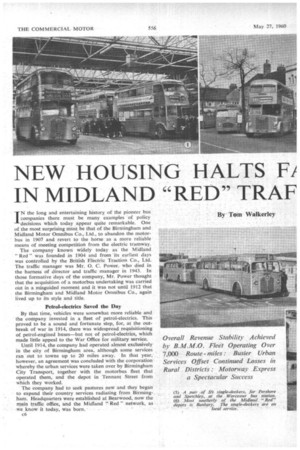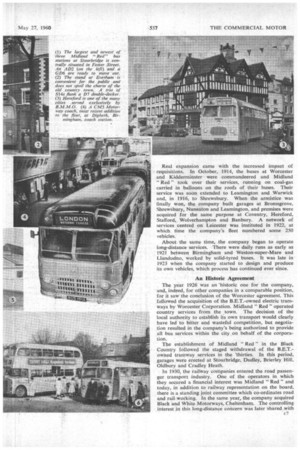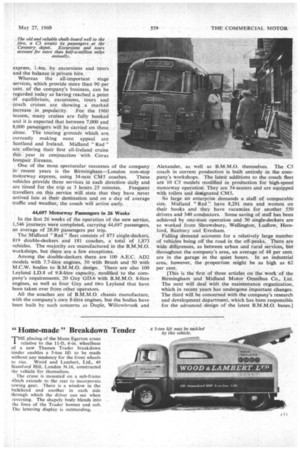NEW HOUSING HALTS Fi IN MIDLAND "RED" TRAF
Page 56

Page 57

Page 58

Page 61

If you've noticed an error in this article please click here to report it so we can fix it.
By Tom Walkeriey
IN the long and entertaining history of the pioneer bus companies there must be many examples of policy decisions which today appear quite remarkable. One of the most surprising must be that of the Birmingham and Midland Motor Omnibus Co., Ltd., to abandon the motorbus in 1907 and revert to the horse as a more reliable means of meeting competition from the electric tramway.
The company known widely today as the Midland " Red " was founded in 1904 and from 'its earliest days was controlled by the British Electric Traction Co., Ltd. The traffic manager was Mr. 0. C. Power, who died in the harness of director and traffic manager in 1943. In those formative days of the company, Mr. Power thought that the acquisition of a motorbus undertaking was carried (nit in a misguided moment and it was not until 1912 that the Birmingham and Midland Motor Omnibus Co., again lived up to its style and title.
Pegild-elecirics Saved the Day By that time, vehicles were somewhat more reliable and the company invested in a fleet of petrol-electrics. This proved to be a sound and fortunate step, for, at the outbreak of war in 1914, there was widespread requisitioning of petrol-engined buses—but not of petrol-electrics, which made little appeal to the War Office for military service.
Until 1914, the company had operated almost exclusively in the city of Birmingham area, although some services ran out to towns up to 20 miles away. In that year,' however, an agreement was concluded with the corporation whereby the urban services were taken over by Birmingham City Transport, together with the motorbus fleet that operated them, and the depot in Tennant Street from which they worked.
The company had to seek pastures new and they began to expand their country services radiating from Birming-. ham. Headquarters were established at Bearwood, now the main traffic, office, and the Midland " Red " network, as Ave _ know it today, was born.'
c6 Real expansion came with the increased impact of requisitions. In October, 1914, the buses at Worcester and Kidderminster were commandeered and Midland " Red " took over their services, running on coal-gas carried in balloons on the roofs of their buses. Their service was soon extended to Leamington and Warwick and, in 1916, to Shrewsbury. When the armistice was finally won, the company built garages at Bromsgrove, Shrewsbury, Nuneaton and Leamington, and premises were acquired for the same purpose at Coventry, Hereford, Stafford, Wolverhampton and Banbury. A network of services centred on Leicester was instituted in 1922, at which time the company's fleet numbered some no vehicles.
About the same time, the company began to operate long-distance services. There were daily runs as early as 1921 between Birmingham and Weston-super-Mare and Llandudno, worked by solid-tyred buses. It was late in 1923 when the company started to design and produce its own vehicles, which process has continued ever since.
An Historic Agreement The year 1926 was an historic one for the company, and, indeed, for other companies in a comparable position, for it saw the conclusion of the Worcester agreement. This followed the acquisition of the B.E.T.-owned electric tramways by Worcester Corporation. Midland " Red " operated country services from the .town. The decision of the local authority to establish its own transport would clearly have led to bitter and wasteful competition, but negotiation resulted in the company's being authorized to provide all bus services within the city on behalf of the corporation.
The establishment of Midland " Red " in the Black Country followed the staged withdrawal of the B.E.T.owned tramway services in the 'thirties. In this period, garages were erected at Stourbridge, Dudley, Brierley Hill, Oldbury and Cradley Heath.
In 1930, the railway companies entered the road passenger transport industry, One of the operators in which they secured a financial interest was Midland " Red " and today, in addition to railway representation on the board, there is a standing joint committee which co-ordinates road arid rail working. In the same year, the company acquired Black and White Motorways, Cheltenham. The controlling interest in this long-distance concern was later shared with
Bristol Tramways and Carriage Co., Ltd., and City of Oxford Motor. Services, Ltd., and from this development, Associated . Motorways was formed.
By 1939, the Midland " Red " fleet numbered 1,309 vehieles, operated from some 30 garages.. all over the Midlands, from Leicester in the east to Shrewsbury in the west, and from Stafford in' the north to • Banbury in the south.'.
. AS for other operators, the war years had the qualities of a:nightmare. To maintain :essential Services, particularly to the factories Spread all-over the Midlands, the emphasis Was continually. on improvisation and ingenuity. Heavy loading: was constant and intense and maintenance was : difficult. 'Replacement was virtually impoSsible.
In the war years, too, the structure of management underwent a eliange: Since "1912, the local management • of the company had been vested in the traffic manager and chief engineer jointly. With the sudden death of Mr. Power in 1943, Mr. D. M. Sinclair, since 1940 the chief engineer, was appointed general manager. In addition he continued to hold the position of chief engineer until 1946, when this office was taken over by Mr. S. C. Vince.
To assist the general manager, four, senior executive appointments were made. They were those of traffic manager (Mr. R. Brandon), staff manager (Mr. L.' H. Youngs), secretary (Mr. F. B. Watts) and engineer (Mr. Vince). Mr. Watts was succeeded by Mr: N. W. Rolfe and Mr. Vince by Mr. E. C. Tuff.
The traffic department at I3earwood is sub-divided into a large number of more or less self-contained offices under the control of the traffic manager and his deputy, Mr. R. K. Cope. These include the stage-carriage and traffic office, which covers fares, time-tables, vehicle allocations and the scrutiny of schedules. Other offices deal with private hire, tours and excursions, coach cruises, publicity and public relations, Road• Traffic Acts, long-distance services and parcels.
The long-distance service department, for operational reasons, is situated at the coach station at Digbeth, and all the charting is carried out here, as well as time-tabling and day-to-day operation of the express services. This department also controls agencies and bookings' for other companies, including air and Continental travel. For c8 convenience the parcels department is also situated in the centre of the city.
In 1944-45, the last full year under, wartime conditions, Midland "Red "'buses: covered 43m. miles and carried 327m. passengers. By 1953, the figures were respectively 76m, and 452m. Since then, the company, like others, has felt the impact of personal transport and the stay-at-home power of television. In 1959,-passengers carried totalled 3701-rn, and the annual mileage had• been reduced somewhat to abotit-74-1m.
It is felt at Bearwbod that a state of stability has now been reached. The opening up of new housing estates has halted the decline in traffic and today increased numbers of short distance-passengers are being carried. It is fully appreciated, of course, that the industry in the •Midlands is by no means out of the wood. The threat from personal transport is no less strong and the diesel train in direct competition with the road services on some routes, has abstracted valuable traffic. This is particularly noticeable between Birmingham and Lichfield.
In the recent difficult years, Midland " Red " has never abandoned a rural route, although sente, inevitably, have had to be pruned. About 32 per cent. of the company's route mileage and between 60 and 70 per cent. of its services are unrenumerative.
By far the most important sector of the company's business is stage-carriage work. The breakdown of passenger figures for 1959 is of interest; stage, 368.6m.; express, 0.44m.; tours, 0.6m.; and contract, 1m. The company operates about 1,000 stage routes, provides some .32 town services and holds 28 express and 97 excursion and tour licences. Its total revenue for the past year was in the region of f91.-m. and fuel tax cost nearly £800,000.
Operating over almost the whole of the Midlands, the company has established divisional superintendent's offices at Birmingham, Dudley. Bromsgrove, Worcester, Hereford, Leicester and Coalville. These look after garage superintendents, traffic assistants, wages, schedules, service running arrangements and the preparation of working arrangements. In addition, there are 33 garages or depots, 45 inquiry offices and more than 100 exclusive booking agencies.
The present route mileage is about 7,000, of which Service X9I (Leicester—Hereford) is the longest at 110.9 miles. For the record, the shortest is Service B2 (Banbury) at 0.9 mile. Of the annual fleet mileage of 74fm., 69.8m. miles is accounted for by the stage services, 2.1m. by express, 1.4m. by excursions and tours and the balance is private hire.
Whereas the all-iMportant stage services, which provide more than 90 per cent. of the company's business, can be regarded today as having reached a point of equilibrium, excursions, tours and coach cruises are showing a marked increase in popularity. For the 1960, season, many cruises are fully hooked and it is expected that between 7,000 and 8,000 passengers will be carried on these alone. The touring grounds which are currently making most appeal are Scotland and Ireland. Midland " Red " are offering their first all-Ireland cruise this year in conjunction with Coras Iompair Eireann.
One of the most spectacular successes of the company in recent years is the Birmingham—London non-stop motorway express, using 34-seat CM5 coaches. These vehicles provide three services in each direction daily and are timed for the trip at 3 hours 25 minutes. Frequent travellers on this service will state that they have never arrived late at their destination and on a day of average traffic and weather, the coach will arrive early.
44,697 Motorway Passengers in 26 Weeks In the first 26 weeks of the operation of the new service, 1,546 journeys were completed, carrying 44,697 passengers, an average of 28.89 passengers per trip_ The Midland " Red " fleet consists of 873 single-deckers, 819 double-deckers and 181 coaches, a total of 1;873 vehicles. The majority are manufactured in the B.M.M.O. workshops, but there are a few exceptions.
Among the double-deckers there are 100 A.E.C. AD2 models with 7.7-litre engines, 50 with Brush and 50 with M.C.W. bodies to B.M.M.O. design. There are also 100 Leyland LD.8 of 9.8-litre capacity, modified to the company's requirements, 20 Guy GD.6 with B.M.M.O. 8-litre engines, as well as fotir Guy and two Leyland that have been taken over from other operators.
All the coaches are of B.M.M.O. chassis manufacture, with the company's own 8-litre engines, but the bodies have been built by such concerns as Duple, Willowbrook and Alexander, as well as B.M.M.O. themselves. The C.5 coach in current production is built entirely in the company's workshops. The latest additions to the coach fleet are 10 C5 models modified in production for high-speed motorway operation. They are 34-seaters and are equipped with toilets and designated CM5.
So large an enterprise demands a staff of comparable size. Midland " Red " have 8,291 men and women on their books and they have vacancies for another 550 drivers and340 conductors. Some saving of staff has been achieved by one-man operation and 30 single-deckers are so worked from Shrewsbury, Wellington, Ludlow, Hereford, Banbury and Evesham.
Falling demand accounts for a relatively large number of vehicles being off the road in the off-peaks. There are wide differences, as between urban and rural services, but throughout the company's area, an average of 48 per cent. are in the garage in the quiet hours. In an industrial area, however, the proportion might be as high as 62 per cent.
[This is the first of three articles on the work of the Birmingham and Midland Motor Omnibus Co., Ltd. The next will deal with the maintenance organization, which in recent years has undergone important changes. The third will be concerned with the company's research and development department, which has been responsible for the advanced design of the latest B.M.M.O. buses.]
















































































































